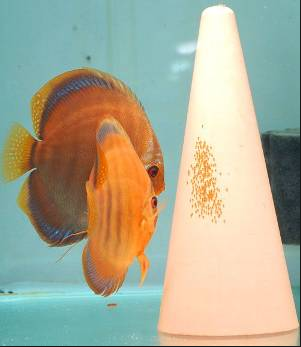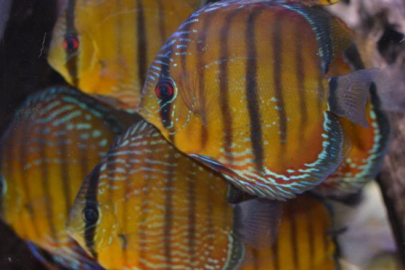How to Breed Discus Fish- All Tips Revealed
Customers always ask me how to breed discus fish.
Breeding of Discus fish is quite difficult in terms of taking care of them and it may be difficult to succeed in having a high survival rate when you first start out. This is why the price of discus fish for sale is higher than your typical aquarium fish. However the beauty it brings about in terms of aesthetic value as well as keeping them as pets overrules all the challenges. The unique thing about them is their ability, meaning young ones, to feed from their parents’ skin. This means therefore they either have to be together with their parents or if they are alone you will have to feed them with a specialized replacement for the nutrients they get from their parents’ skin. Either way, the two methods must provide an environment that encourages breeding. In this article I will describe how to breed discus in two different methods. The two methods are discussed below.
1.
Natural Forming of Breeding Pairs
How to breed discus fish by the natural forming of breeding pairs is your most economical way of breeding discus. This method involves making an environment that enables the young Discus to pair off on their own and form a breeding pair. The process involves a number of measures:-
i) Ensure you keep a large number of discuss fish in order to have a higher probability of having both males and females. The minimum number to give you the best odds of a breeding pair is at least 12 discus fish. This is mainly because it is impossible to visibly tell the gender when they are young. Females reach maturity and start mating at about 9 months of age but males take up to 13 months. The discus must form pairs on their own. it is almost impossible to get a proven male and female and have them breed successfully.
ii) Ensure they have a spacious room. The Discus fish will not breed effectively if the aquarium is small. The discus tank should be at least 38cm deep. This height will ensure the fish tank holds enough water needed by the discus in it. Ensure nitrites, nitrates and ammonia is of the right measurement. If that is not the case, there is need for adjustment. This can be done by use of a test kit. Both nitrites and ammonia should be below 0 ppm whereas on the other hand nitrates should be below 20 ppm.
Breeding Continued
iii) Aquarium water conditions should be accurately tested. The water pH should be stable at 6.5 pH whereas temperature should be 86F degrees. Also, mineral content should be 100-200 microsiemens. These conditions should always be adjusted when they fluctuate in order to achieve stability which the discus fish need for survival and breeding.
iv) Change 10% of the water daily. This will ensure the breeding of discus happens as the tank will be clean. This should be accompanied by removal of dirt at the bottom of the tank as well as cleaning of the tank walls when necessary.
v) Ensure they feed on animal protein. These come in different forms like black worms, live brine shrimp, and beef heart flakes. These will provide the discus with nutrition necessary for breeding. Additional vitamin supplements may help sometimes as well.
vi) Put various spawning sites in the tank for spawning. You can use a variety of things for this including flower pots turned upside down. However, it shouldn’t be an issue if they choose to lay their eggs next to the ground.
vii) Look out for pairs that have mated. You can tell this by observing their behavior. They may hang together in a corner. Once you have confirmed a breeding pair you must move the pair into their own aquarium with a bare bottom. Do not use any substrate that way the water remains very clean. The ideal breeding aquarium should be a minimum of 10 gallons but preferably a 20 gallon long aquarium.
2.
Breeding discus with proven discus pairs
After successful breeding, you will need to know how to raise the discus with their parents. This involves the following:
i) Keep an eye on hatching eggs. This usually happens after 2-3 days after which the young ones may stay there for longer. Ensure the parents don’t eat the eggs after they hatch. You may want to put a mesh or screen around the eggs to prevent the parents from eating them. If the eggs turn white that means they were not fertilized and have developed fungus. Fertilized eggs will have a golden/brownish color.
ii) Reduce water levels right before fry detach.
iii) Feeding the young fish. For the first 5 days the fry will attach to the sides of the parents and will eat the white mucus that forms on the parents body. Keep a close eye on this because as the days go on they can start biting the skin of the parents which will cause skin infections. Introduce baby brine shrimp around 4 times a day. This should be done 4-5 days after the fry have been swimming. Once the fry are completely eating on their own and are no longer attached to the parents you must separate the fry from the parents. As the fry get larger start feeding them premium discus flakes as well as beef heart flakes and start introducing them to frozen blood worms once they reach one inch in size.
If everyone knew how to breed discus fish successfully, the price of discus fish would be much lower and discus fish sales would suffer. There are many reputable discus fish experts in the hobby including: Dr. Eduard Schmidt-Focke, Mr. Goh Eng Khoon, Mr. Jack Wattley, Mr. Andrea Andreas, Mr. Dickson Lim and Mr. Ricky Lim just to name a few. Once you learn how to breed discus fish successfully it is very rewarding.
Copyright 2020 – Discusguy.com. All Rights Reserved






